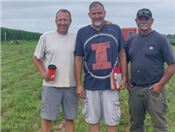Farmers, Researchers Break Ground With New Guidelines For Budding Hemp Crop

Simple Livin’ Farms in Morton was the Illinois site for the Midwestern Hemp Database’s hemp cultivar trial in 2021. University researchers worked with hemp producers (left to right) Paul Grethey, Chad Huette, and Al Diehl to gather information on how 18 hemp cultivars performed here compared to other states.
Photo credit: Phillip Alberti
EMILY STEELE
URBANA, ILLINOIS
In 2019, farmers across Illinois launched into the first growing season for industrial hemp with mixed results. Hemp is one of the newest and fastest growing speciality crops in the Midwest, and University of Illinois Extension is helping producers keep up by providing cutting edge research updates straight from the field.
By collecting data from more than 180 hemp growers over the past two years, Illinois Extension researchers now have a better understanding of how to produce hemp and are sharing that information directly with growers through the Midwestern Hemp Database.
Illinois legalized the growth of industrial hemp, which is used for fiber and food, in 2018. Demand for the new crop outpaced the data.
Phillip Alberti, Illinois Extension commercial agriculture educator, recognized that producers did not have basic information about how to grow the newly available crop. The database project is a collaboration between Midwestern researchers and growers.
“By working with growers to get data directly from the field, we’ve been able to learn a lot in a short amount of time,” says Alberti.
“We’re helping producers grow profitable hemp crops by providing recommendations based on the latest information coming in from their fields.”
Information in the database comes from hemp producers who submit field samples in exchange for discounted cannabinoid level testing through partner laboratories. Researchers share the results with the public through the interactive dashboard to help growers make informed decisions on production practices and hemp cultivars. During the growing season, field data is updated weekly giving growers access to the latest information.
Alberti recently published three reports from the 2021 growing season which are available at go.illinois.edu/HempDatabase.
Extension staff worked with Simple Livin’ Farms in Morton to plant and track the performance of 18 cultivars to learn more about high cannabinoid hemp varieties. They examined plant height, uniformity, flowering time, biomass yield, and cannabinoid content. The study was replicated in other Midwestern states to understand regional differences. The results of the 2021 Illinois Variety Trial are available at go.illinois.edu/MHD2021trial.
The database has helped identify a list of eight cultivars that have the potential to comply with state and federal regulations limiting the cannabinoid levels. As part of the Cultivar Check program, Extension staff worked with producers to grow and test those varieties. The results, available at go.illinois.edu/MHD2021cultivar, demonstrated the best time to harvest hemp in order to meet compliance was about five to six weeks after plants flowered.
Overall results for the 2021 growing season are available in the Midwestern Hemp Database report at go.illinois.edu/MHD2021. The report has advice for producers, information on plant yield and growth characteristics, cannabinoid production and sampling, and a list of plant varieties that have good potential for the Midwest.
Producers can apply to the program at go.illinois.edu/HempDatabase.
Participants receive discounted cannabinoid level testing. For more information, contact Alberti at palberti@illinois.edu or (217) 300-7392.
The database is a collaborative project between four Midwestern land- grant universities: Michigan State, University of Illinois, University of Wisconsin-Madison, and Purdue University. The project also partners with the private laboratories Rock River Laboratory, Inc., Pride Analytics and Consulting, and ACT laboratories. ∆
EMILY STEELE: Media Communications Coordinator, Illinois Extension